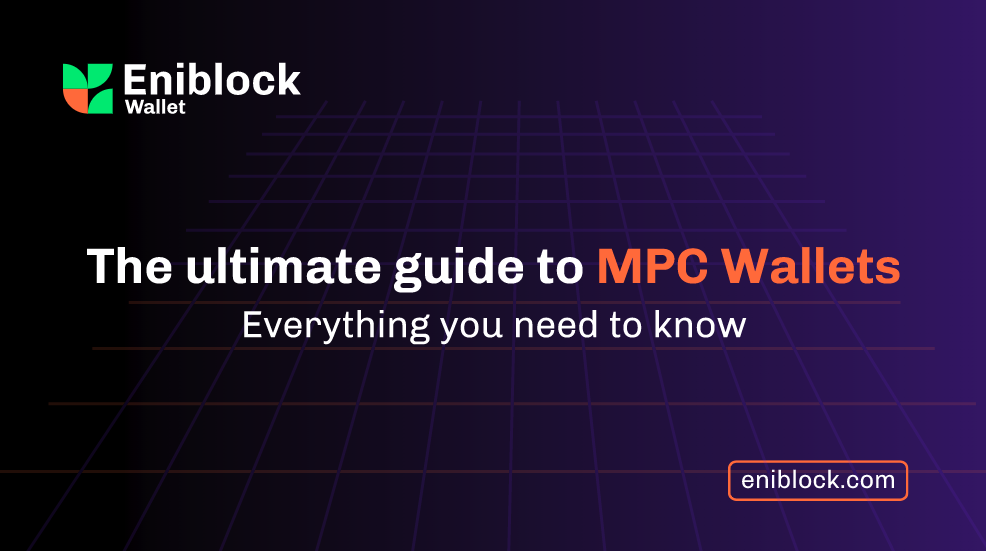
TechnologyWeb3
The ultimate guide to MPC Wallets: Everything you need to know

The arrival of ERC-4337 on Ethereum and EVM-compatible blockchains has opened the doors to account abstraction, paving the way for a better user experience in web3 wallets. With the emergence of “smart accounts”, companies are now turning to smart contract wallets like MPC wallets to provide improved user experiences, security, and streamlined transactions.
But what exactly is an MPC wallet? It’s a smart contract wallet that uses Multi-Party Computation technology to securely manage digital assets on the blockchain. Unlike traditional wallets, MPC wallets use advanced cryptography to ensure the private key is never exposed or stored in one location, adding an extra layer of security.
MPC wallets are crucial to the web3 ecosystem as they offer enhanced security, flexibility, and control for the web3 wallet experience. They enable improved security and risk mitigation, more efficient asset management and transfer, advanced access control and permissions, and streamlined collaboration between different parties.
In this blog post, we’ll explore everything you need to know about MPC wallets, including how they work, their benefits, and how to use or build one whether you’re a user or developer. By leveraging MPC technology, web3 wallets can provide a better user experience and make digital asset management more secure and efficient.
How does an MPC wallet operate?
An MPC wallet operates through Multi-Party Computation (MPC), a cryptographic technique that allows multiple parties to jointly compute a function without revealing their individual inputs. In the case of an MPC wallet, the private key is split into various shares, with each share being distributed to different parties, such as wallet users or trusted servers.
This approach enhances security as no single party has access to the complete private key, eliminating single points of failure. When a transaction needs signing, the involved parties collaborate to generate the signature without reconstructing the private key, ensuring that the assets remain secure throughout the process.
When a transaction is initiated, the parties, typically the user and the wallet provider’s server, commence an MPC protocol to jointly sign the transaction. Each party holds a share of the private key, which they use to compute their individual signature shares. These shares are then combined to produce a valid signature for the transaction.
Throughout the process, the private key shares are never exposed, and the parties cannot access each other’s shares. This ensures that even if an attacker compromises one party, they cannot gain full control over the wallet or the assets. By leveraging MPC technology, MPC wallets offer a secure and efficient way of managing digital assets.
What are the use cases of an MPC wallet? Here are some examples:
- Team wallets for decentralized organizations and companies: MPC wallets provide a secure way for multiple stakeholders to manage and approve transactions together. This is useful for decentralized organizations, companies, and project teams that require a secure and efficient method of managing their assets.
- Escrow services: MPC wallets can facilitate secure escrow services, with parties holding private key shares, ensuring that transactions only go through when all conditions are met.
- Multi-user wallets for investment clubs or consortiums: MPC wallets enable groups of investors to jointly manage their investments, make decisions together and require consensus for transactions.
- Secure key management for exchanges and custodial services: MPC wallets can enhance the security of exchanges and custodial services, ensuring that the private keys for user assets are distributed and not susceptible to single points of failure. For instance, exchanges can use MPC wallets to provide secure and efficient management of digital assets on behalf of their users.
- Joint custody for high net worth individuals: High net worth individuals can use MPC wallets to hold their assets in joint custody with trusted parties, such as family members or financial advisors. This provides an extra layer of security, as no single party can access the assets on their own.
- Cross-chain interoperability: MPC wallets can facilitate cross-chain interoperability by enabling multiple parties to control and manage assets across different blockchain networks. This allows for efficient asset management and transfer across various ecosystems, creating new opportunities for innovation and collaboration.
- Secure voting systems: MPC wallets can be used to create secure and transparent voting systems, where each voter holds a private key share, and votes are only counted when all conditions are met. This provides a secure and tamper-proof way to conduct voting, ensuring that the results are accurate and trustworthy.
- Gaming and digital collectibles: MPC wallets can be used to secure and manage digital assets in gaming and collectible ecosystems. By leveraging MPC technology, game developers and collectors can jointly manage their assets and prevent unauthorized access, theft, and fraud. This can lead to more innovative gaming experiences and more secure digital collectibles markets.
MPC wallets provide various use cases for individuals, organizations, and institutions that require secure and efficient management of digital assets. By leveraging MPC technology, MPC wallets offer enhanced security, flexibility, and control for the web3 wallet experience, enabling a better user experience than traditional wallets.
Benefits and drawbacks of using an MPC wallet:
Benefits:
- Improved security by distributing private key shares to different parties, mitigating the risk of a single point of failure and reducing the chances of theft or unauthorized access.
- More granular access control and permission settings, useful for organizations requiring strict control over their digital assets.
- Streamlined collaboration and decision-making by requiring multiple parties to sign off on transactions, encouraging collaboration and collective decision-making.
- Support for complex transaction requirements, such as time-locking, multi-step approval processes, and spending limits, essential for organizations with complex financial operations or compliance requirements.
- Chain-agnostic, supporting all EVM-compatible blockchains (if ERC-4337 compliant).
Drawbacks:
- Increased complexity compared to single-signature wallets, requiring technical knowledge for proper setup and management, which may be overwhelming for some users.
- Potentially slower transaction times due to multi-signature requirements, as multiple signatures are needed for transactions in MPC wallets.
- May require more technical expertise to set up and manage, making it a barrier for those who lack technical knowledge or prefer simpler solutions.
- Limited adoption, with not all wallet providers offering MPC wallets, making it challenging for users to find compatible solutions and obtain support and resources for troubleshooting and maintenance.
- As MPC wallets require multiple parties to sign off on transactions, it may make it difficult to perform quick and simple transactions as compared to single-signature wallets.
MPC wallets vs. Multisig wallets
MPC wallets and Multisig wallets are both tools for improving security and control over digital assets, but they are not the same. MPC wallets use a cryptographic technique where the private key is divided into multiple shares, while Multisig wallets require multiple signatures from different parties to authorize transactions.
With MPC wallets, the private key is split into shares and jointly computed by the parties involved, without ever being fully reconstructed. This approach eliminates a single point of failure, making it more secure. In contrast, Multisig wallets require each participant to have their own distinct private key and specify a required number of signatures to approve transactions.
In summary, while both MPC and Multisig wallets involve multiple parties, they differ in how they handle private keys and transaction approvals. MPC wallets divide the private key into shares, while Multisig wallets require distinct private keys for each participant.
Top MPC Wallets
If you’re looking for an MPC wallet, there are several options available in the market today. Here are some popular examples:
- Eniblock
- DFNS
- Coinbase
- ZenGo
- Fireblocks
- Mirror World
- UniPass
- Marble Wallet
Each of these wallets has its unique features and benefits, so it’s essential to research and compare them to determine which one aligns best with your needs.
FAQs about MPC wallets:
What is an MPC Wallet?
An MPC Wallet is a type of smart contract wallet that uses Multi-Party Computation to manage digital assets on the Ethereum blockchain securely.
Is MetaMask an MPC Wallet?
No, MetaMask is not an MPC wallet. It uses a single private key for transaction signing and asset management.
Is Coinbase Wallet an MPC Wallet?
No, Coinbase Wallet is not an MPC wallet. However, Coinbase has recently launched a separate MPC wallet offering.
Can an MPC wallet be hacked?
While no wallet is completely immune to hacking, MPC wallets provide enhanced security compared to single-signature wallets due to the distributed nature of private keys.
What happens if one of the parties holding a share of the private key becomes unavailable?
MPC Wallets can be configured with different threshold schemes, allowing for a specific number of parties to sign a transaction successfully, even if some parties are unavailable.
Can I switch from a single-signature wallet to an MPC wallet?
Yes, you can transition from a single-signature wallet to an MPC wallet by creating a new wallet and transferring your assets. Follow best practices for securing your private key shares during this process.
Is it possible to recover lost private key shares in an MPC wallet?
It may be possible to recover lost private key shares depending on the wallet provider’s specific implementation of MPC technology.
Are MPC wallets compatible with EVM chains?
Yes, MPC is chain-agnostic and can be applied to all EVM-compatible chains.
Final thoughts
In conclusion, MPC wallets offer a promising future for securing digital assets on Ethereum and EVM-compatible blockchains. With their enhanced security features and flexibility, MPC wallets provide a unique approach to smart contract wallet solutions. We hope this article has provided you with a better understanding of the benefits of using an MPC wallet and how it compares to other solutions like Multisig wallets. If you’re interested in building web3 apps with integrated MPC wallets, consider using Eniblock’s web3 SDKs to get started.
Why should you consider Eniblock’s SDK?
Eniblock offers a comprehensive MPC Wallet-as-a-service solution through its Web3 SDK tailored for enterprises and brands. Its all-in-one SDK solution is designed by developers with web2 expertise to streamline the transition to the decentralized web. With Eniblock’s wallet-as-a-service API, you can onboard all your users to Web3 with a simple and embeddable wallet JavaScript library. This solution eliminates the need for seed phrases and provides optimal security and privacy, making it easy to generate millions of wallets effortlessly.
By integrating Eniblock’s MPC wallet solution, you can transform your current Web2 customer base into a dynamic Web3 community, enhance your revenue, and build brand loyalty by implementing innovative approaches, tailored experiences, and attractive rewards for your customers.



